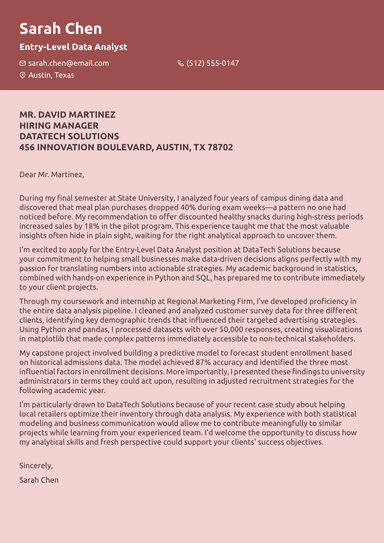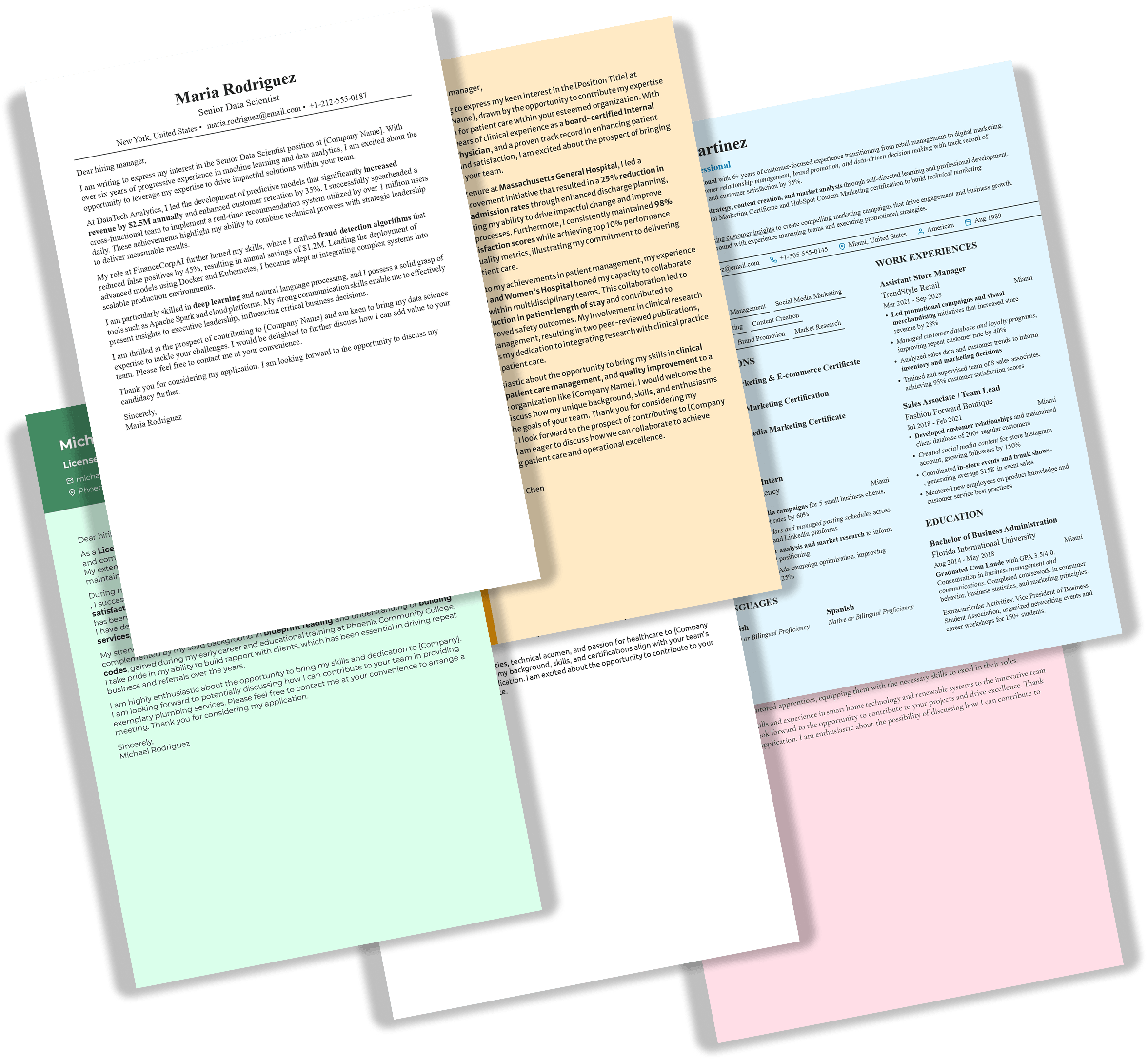How to Write a Data Analyst Cover Letter: Guide + 3 Examples
This complete guide with expert tips and real examples will teach you how to write a compelling cover letter — fast and stress-free!
Edit this cover letter
Landing a data analyst position isn't just about having the right technical skills—it's about presenting them to the hiring managers. Your data analyst cover letter serves as the bridge between your resume's hard facts and your potential employer's specific needs. You need to demonstrate real understanding of business problems and showcase specific, measurable impacts you've made.
In this guide, we break down everything you need to craft a data analyst cover letter that actually gets results. You'll discover the essential components that make hiring managers want to learn more, see real examples from successful candidates, and get proven cover letter templates you can customize for any position. More importantly, you'll learn how to avoid the common mistakes that send most applications straight to the rejection pile.
- A standout data analyst cover letter balances technical expertise with business acumen, demonstrating both analytical thinking and clear communication.
- It should showcase quantifiable achievements and relevant industry knowledge.
- Well-structured data analyst cover letters feature clear sections—header, opening, body, and closing.
- Candidates should avoid generic templates, vague technical listings, and formatting errors, ensuring their application is personalized, ATS-optimized, and professionally written.
What Makes a Data Analyst Cover Letter Stand Out?
Things that make a data analyst cover letter stand out are technical competence and business acumen in equal measure. Unlike many other roles where soft skills might dominate the conversation, data analyst positions require a unique blend of analytical thinking and communication abilities that your cover letter must showcase effectively.
Keep in mind that it’s a growing profession. According to the U.S. Bureau of Labor Statistics, data analyst employment is projected to grow 34% in the next decade. This is much faster than average for all occupations, and to be the best candidate, your data analyst cover letter must tell a story of problem-solving.
The key is to translate technical work into business language. Hiring managers, especially those without deep technical backgrounds, need to understand the value you bring. When you mention creating a data visualization dashboard, you have to include the impact it made for the company.
Here’s a good example:
I’ve made a data visualization dashboard that reduced report generation time from three hours to fifteen minutes. This freed up the team to focus on strategic analysis rather than manual reporting.
Also, industry knowledge is important. For instance, a data analyst in healthcare should understand HIPAA compliance and clinical workflows. With specialized knowledge and technical skills, you create a compelling case for your candidacy.
As mentioned earlier, communication skills deserve special emphasis because so much of the role involves presenting findings to non-technical stakeholders. Your cover letter itself serves as evidence of your ability to communicate complex information clearly and persuasively—a skill that's absolutely essential in most data analyst positions.
Data Analyst Cover Letter Examples
These three data analyst cover letter examples demonstrate how to showcase your analytical skills and quantifiable achievements, regardless of your experience level. Use these as inspiration to craft your own persuasive cover letter.
Entry-Level Data Analyst Cover Letter
Experienced Data Analyst Cover Letter
Career Change to Data Analyst Cover Letter
How to Write a Data Analyst Cover Letter: 4 Essential Sections Explained
Writing any cover letter requires thorough preparation. Before you write a single word, research the company. Review their website, recent projects, and industry challenges. Understanding their business needs allows you to tailor your data analyst cover letter and demonstrate how your analytical skills solve their specific problems.
After you’ve done the research, you can start writing your cover letter. Let’s examine which essential sections you need to include in your data analyst cover letter and how to write them.
#1. Header and Contact Information
Your cover letter heading should mirror your data analyst resume to create a cohesive professional image. Make sure to include your:
- Full name
- City and state (especially if you're applying for remote positions)
- Phone number
- Email address
- LinkedIn profile
Also, many data analysts include links to their GitHub profiles or personal portfolio websites in their headers. This gives hiring managers immediate access to code samples and project demonstrations that support the claims made in your cover letter. However, ensure these links actually showcase relevant, polished work rather than incomplete experiments.
#2. Opening Paragraph
The opening paragraph of your data analyst cover letter needs to accomplish three things quickly: capture attention, mention the specific position, and preview your most compelling qualifications. Start with a strong statement about a specific achievement or unique qualification that directly relates to the role.
Let’s see a good example of how to do it:
When I discovered that customer churn was costing my previous company $2.3 million annually, I developed a predictive model that identified at-risk accounts with 89% accuracy, ultimately reducing churn by 23% within six months. I'm excited to bring this kind of analytical problem-solving to the Senior Data Analyst position at [Company Name].
This opening immediately demonstrates impact, shows technical capability, and connects to business outcomes. It's specific enough to be memorable while broad enough to apply to most data analyst roles. Avoid generic openings like "I am writing to express my interest" or "I saw your job posting"—these waste valuable space and fail to differentiate you from hundreds of other applicants.
#3. Body Paragraphs
Your body paragraphs should address the specific requirements mentioned in the job posting and show that you’re a good fit. Structure these sections around your most relevant experiences, but don't simply repeat everything from your resume. Instead, expand on key achievements with additional context about your methodology and results.
Focus on projects that demonstrate the full analytical lifecycle and quantify your achievements whenever possible. For instance, describe how you identified data quality issues in a customer database, developed cleaning procedures that improved accuracy by 35%, and created automated validation checks that prevented similar problems in the future.
Also, include at least one example that demonstrates collaboration with non-technical stakeholders. Data analysts rarely work in isolation, so show that you can translate technical findings into actionable business recommendations. Describe presenting analysis results to executives or working with marketing teams to implement data-driven campaign strategies.
#4. Closing Paragraph
Your closing paragraph should reinforce your enthusiasm for the specific role and company while providing a clear next step. Reference something specific about the company, e.g. their recent expansion into new markets, their reputation for data-driven decision making, or their innovative use of machine learning in their industry. Express confidence in your ability to contribute immediately while remaining appropriately humble.
Here’s a good example:
I'm confident that my experience turning complex datasets into actionable insights would help [Company Name] continue making data-driven decisions that drive growth. I'd welcome the opportunity to discuss how my analytical skills could support your team's objectives during an interview.
Always include your availability for interviews and a professional sign-off. Avoid being too pushy about follow-up timelines, but do indicate that you're eager to move forward in the process.
5 Common Data Analyst Cover Letter Mistakes to Avoid
Even qualified candidates sabotage their chances with avoidable cover letter mistakes. Let’s examine five most common errors and how to prevent them.
- Using generic templates without customization. Hiring managers instantly recognize phrases like "passionate about data" or "detail-oriented professional" that appear in hundreds of applications. Avoid this by researching each company thoroughly and referencing specific projects, challenges, or business needs that align with your experience.
- Listing technical skills without business context. Simply cataloging programming languages and tools (Python, R, SQL, Tableau) without explaining their business impact makes your application forgettable. Instead of stating "proficient in Python," explain how you used Python to analyze customer behavior data that increased retention by 25% or automated reporting processes that saved 20 hours weekly.
- Repeating the resume without adding value. Your cover letter shouldn't merely restate what's already on your resume. If your resume mentions building a predictive model, your cover letter should explain the business problem it solved, your analytical approach, and the decision-making impact it created.
- Submitting unprofessional or error-filled applications. Poor formatting, inconsistent fonts, grammatical errors, or typos undermine even strong content and suggest lack of attention to detail—critical for data analysts. Proofread multiple times, use spell-check tools, and have someone else review your letter before submission to catch errors you might miss.
- Ignoring ATS optimization. Applicant Tracking Systems scan for relevant keywords and can't process complex formatting like tables, text boxes, or unusual fonts. Use standard fonts (Arial, Calibri, Times New Roman), avoid graphics or columns, and naturally incorporate keywords from the job description throughout your letter. Include specific skills, tools, and qualifications mentioned in the posting to ensure your application passes automated screening.
Ready to Create a Data Analyst Cover Letter That Gets Results?
Use ResumeBuilder.so's AI-powered suggestions and professional templates to craft applications that stand out from the competition. Our ATS-optimized platform helps you highlight your analytical skills effectively while maintaining the professional presentation that hiring managers expect.
Start building your winning application today with our resume and cover letter builder. Join thousands of successful candidates who've landed their dream data analyst positions using our expert guidance.
Final Thoughts
Writing an effective data analyst cover letter requires balancing technical expertise with clear business communication. A strong application demonstrates not just what you can do with data, but how your analytical work creates measurable business value.
Remember that your cover letter serves as evidence of your communication skills, which are just as important as your technical abilities in most data analyst positions. Hiring managers want to see that you can translate complex analytical findings into actionable insights that non-technical stakeholders can understand and implement.
Customization remains crucial for every application. Take time to research the organization, understand their challenges, and position your experience as directly relevant to their needs. Also, remember that your resume and cover letter work together to tell your professional story. Use it to expand on key achievements from your resume and provide additional context about your work experience.
Data Analyst Cover Letter FAQ
#1. What should I include in a data analyst cover letter?
Your data analyst cover letter should include specific technical skills like Python, R, SQL, and data visualization tools, but more importantly, it should demonstrate how you've used these skills to solve business problems. Focus on quantified achievements, relevant industry experience, and examples of how your analysis led to measurable business outcomes.
#2. How long should a data analyst cover letter be?
A data analyst cover letter should be one page, typically 250-400 words across 3-4 paragraphs. Focus on your most relevant achievements and skills rather than trying to include every detail of your experience.
#3. Should I mention specific software tools in my cover letter?
Yes, mention relevant software tools like Python, R, SQL, Tableau, or Excel when they match the job requirements and you have substantial experience with them. However, don't simply list tools—explain how you've used them to solve specific business problems.
#4. How do I write a cover letter with no data analyst experience?
Focus on transferable skills from other roles, relevant coursework, personal projects, and your passion for data analysis. Highlight experience with Excel, research projects, statistical coursework, or any situation where you analyzed information to make recommendations. Emphasize your ability to learn quickly and your genuine interest in pursuing a data analyst career path.
#5. Do I need different cover letters for different data analyst roles?
Yes, customize each cover letter to address specific job requirements and company needs. This customization demonstrates genuine interest and helps you stand out from generic applications.
#6. Should I mention certifications in my cover letter?
Include relevant certifications briefly, especially if they're mentioned in the job posting or represent industry-standard credentials. Google Analytics, Microsoft Excel Expert, or specific programming certifications can strengthen your application. However, focus more on how you've applied the knowledge gained from these certifications rather than simply listing credential names.
#7. How do I address career gaps in my data analyst cover letter?
Address career gaps honestly but briefly, focusing on any relevant skills you developed during the gap period. The key is to quickly redirect attention to your qualifications and enthusiasm for the role rather than dwelling on the gap.
#8. Should I include salary expectations in my cover letter?
Generally, avoid mentioning salary expectations in your cover letter unless specifically requested in the job posting. Use your cover letter to focus on the value you bring to the organization. Salary negotiations are better handled during the interview process or when you have a job offer.
#9. How do I make my cover letter stand out for remote data analyst positions?
For remote work positions, emphasize your experience with virtual collaboration tools, self-directed work habits, and clear communication skills. Mention specific examples of successful remote projects, your home office setup, and your ability to manage time zones or asynchronous communication.


